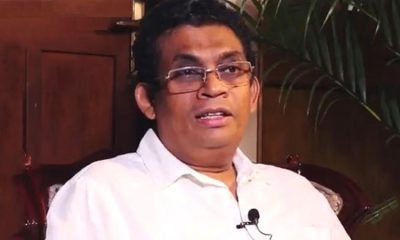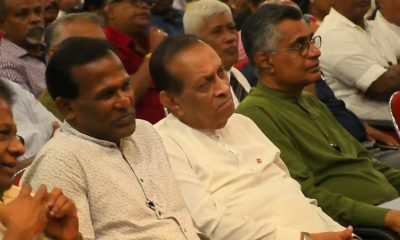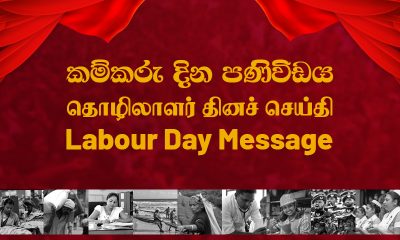Features
May Day: Further splits surface, combined attack on JVP while MR issues warning
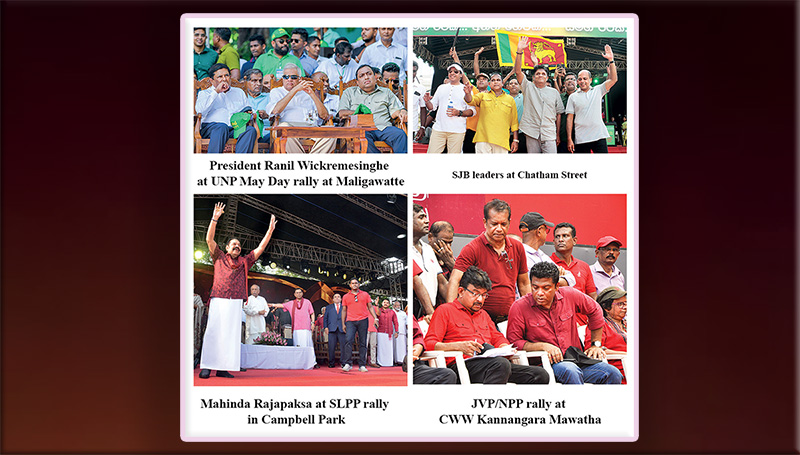
UNP delays official announcement on RW’s candidature as Namal presses for an opportunity
By Shamindra Ferdinando
In spite of determined UNP’s efforts, the party couldn’t convince SJB MPs to switch their allegiance to President Ranil Wickremesinghe in time for this year’s May Day rally chaired by the green leader at Maligawatte, the main Opposition party said.
Gampaha District SJB parliamentarian Kavinda Jayawardena told The Sunday Island that regardless of the UNP’s repeated invitations, the party was sure none in its parliamentary group would join President Wickremesinghe in the run-up to the presidential poll.
UNP General Secretary Palitha Range Bandara, on several occasions, invited the SJB which broke awa from the UNP before the last election to extend their support to Wickremesinghe, thereby strengthening his party ahead of crucial national elections.
SJB MP Nalin Bandara thumbed his nose at the UNP General Secretary over their failure to win over members of the main Opposition party. Addressing the SJB May Day rally at Chatham Street, the former UNP State Minister asked the UNP General Secretary what went wrong with their plans.
The UNP had to be happy with just Moneragala District SLPP MP Gayeshan Nawanandana who switched his allegiance to their side. Interestingly, Nawanandana, a first-time entrant to parliament contested the last general election with veteran politician Vasudeva Nanayakkara’s blessings.
The UNP’s decision not to officially announce Ranil Wickremesinghe candidature at the forthcoming presidential election at its Maligawatte May Day rally raised many eyebrows. The Opposition is going to drum-up this issue in the coming days. However, Minister Harin Fernando and former Minister Akila Viraj Kariyawasam referred to the forthcoming presidential election with the latter acknowledging the continuing disagreement between the UNP and the SLPP regarding Wickremesinghe’s candidature.
Kariyawasam, who with all his fellow UNP MPs failed to retain his Kurunegala district seat at the last election proudly declared that disgraced Health Minister Keheliya Rambukwelle being behind bars was a Wickremesinghe achievement.
Both the UNP and SJB held rallies on streets, packing participants into long narrow spaces, thereby constraining participation while the SLPP gathered at Campbell Park where former President Mahinda Rajapakasa declared that the outcome of the presidential election depended on SLPP support for the winner. The twice president and ousted premier warned that no one could win unless he/she reached a consensus with the pohottuwa. On stage with MR were Premier Dinesh Gunawardena, Basil Rajapaksa and new National Organizer Namal Rajapaksa widely believed to be the choice of an influential section of the SLPP to contest the presidential poll unless an agreement could be reach with Wickremesinghe to call early parliamentary polls.
Hence MP Namal Rajapaksa’s questioning at the May Day rally what he called “short-term decisions” should be examined in the context of his presidential ambitions. Interestingly, among those on the front row of the SLPP rally was businessman Dhammika Perera, MP, in his trademark blue suit and red tie in contrast to other informally clad participants. Perera has been repeatedly mentioned as a possible presidential candidate in case ongoing talks between Wickremesinghe and Basil Rajapaksa fail.
The SJB secured 54 seats, including seven National List slots, the second largest group elected at the last parliamentary polls in August 2020, whereas the parent UNP was able to scrape just one National List seat.
MP Jayawardena said that as the UNP hadn’t been so far able to propose a tangible plan of action to overcome the continuing economic/political/social crisis, it couldn’t expect political parties to extend their support to the UNP leader.
Two SJB MPs, Manusha Nanayakkara and Harin Fernando, during Ranil Wickremesinghe’s tenure as premier, joined the government in May 2022. But since he became president in July 2023, no SJB MP switched his or her allegiance to RW. However, the absence of Dr. Rajitha Senaratne and Thalatha Atukorale, both ex-ministers was noted while SJB Chairman Field Marshal Sarath Fonseka, MP, who has been in loggerheads with Sajith Premadasa left the venue before the conclusion of the day’s proceedings. Reportedly Fonseka had not been given a speech.
On Wednesday morning, the president joined the Ceylon Workers Congress, widely regarded as the strongest trade union/political party among plantation workers, at its May Day rally at the Kotagala public grounds. The single largest political force representing the upcountry Tamils, the CWC now supports Wickremesinghe after quitting the ruling SLPP on whose ticket it ran at the last parliamentary election. Jeevan Thondaman represents the CWC in Wickremesinghe’s cabinet while Senthil Thondaman is the governor or the Eastern Province.
The Sunday Island learns that the CWC had been negotiating with the SJB but decided to go along with Wickremesinghe on the basis of the agreement on a Rs 1,700 minimum daily wage for plantation workers announced on their May Day platform on Wednesday.
Clearly, Wickremesinghe and Thondaman wrong-footed Premadasa, whose party in collaboration with Palani Digambaram, MP, organized a May Day rally at Talawakelle. Although former national cricket captain Arjuna Ranatunga’s appearance caught public attention, the declaration of Rs. 1,700 daily wage hogged the limelight.
The EPDP, represented in Cabinet by Jaffna District MP Douglas Devananda, joined the ruling SLPP’s rally at the Campbell Park. His spokesperson Nelson Edirisinghe told us that the party would support Wickremesinghe at the forthcoming presidential poll. He clarified that the EPDP contested the last parliamentary election on its own and won two seats in Jaffna and Vanni.
The ruling SLPP held its rally, minus some of its members, as well as key constituents of the original coalition. The SLPP that had won 145 parliamentary seats, including 17 National List places have lost nearly 30 MPs since the last general election. Of them, six led by former External Affairs Minister Prof. G. L. Peiris joined the SJB’s Colombo rally. Other members of Prof. Peiris’s group were Dilan Perera, Dr. Nalaka Godahewa, Wasantha Yapa Bandara, K.P.S. Kumarasiri and Dr. Upul Galappaththy.
Other original members of that group, including Matara District MP Dullas Alahapperuma who ran for president against Wickremesinghe in a parliamentary vote after Gotabaya’s resignation, hadn’t been able to reach a consensus regarding their future course of action, sources said. Therefore, they refrained from either joining any other political party or organizing an event of their own to mark May Day. That group included MPs Alahapperuma, Prof. Channa Jayasumana, Charitha Herath, Ratnapala Ratnasekera, Lalith Ellawela and Thilak Rajapaksha.
Patali Champika Ranawaka, who entered Parliament on the SJB ticket, didn’t organize a May Day event. A senior spokesman said that they were preparing for the convention of their party due shortly. Former Minister Ranawaka leads the Eksath Janaraja Peramuna that received the Election Commission’s recognition last year. Another elected member of the SJB to skip May Day was Kumara Welgama, leader of New Lanka Freedom Party.
The Wimal Weerawansa-led Uththara Lanka Sabhagaya (ULS), which is another active SLPP rebel group, held its rally at the Lalith Athulathmudali playground, Kirulapone. National Freedom Front (NFF) leader and former Minister Wimal Weerawansa chaired the meeting, in his capacity as the Chairman of the alliance comprising the Communist Party (represented by Dr. G. Weerasinghe and Weerasemana Weerasinhe, MP), Pivithuru Hela Urumaya of MP Udaya Gammanpila, Our Power of People Party of Ven. Atureliye Rathana, MP, in his capacity as the leader of Dharani Jathika Sabhawa. and civil society group Yuthukama (Gevindu Cumaratunga) joined the rally.
This party declared in unison at its May Day rally that it was the only grouping genuinely opposed to President Wickremesinghe’s agenda inimical to national interests. Addressing quite a significant crowd, former minister Gammanpila found fault with ousted President Gotabaya Rajapakasa for ruining the mandate received by him as a result of caving into US interventions. The outspoken lawmaker named US Ambassador Julie Chung and dual citizen Basil Rajapaksa as the two advisors who caused the President’s downfall.
Gampaha District MP Nimal Lanza’s ‘New Alliance,’ consisting of SLPP MPs, too, kept away from Campbell Park. That group has pledged its support to President Wickremesinghe but decided not to join the UNP rally until the official declaration of Wickremesinghe candidature. It was quite agitated by the UNP’s decision to further delay the official announcement.
State Minister Lasantha Alagiyawanna said that the majority of the SLFPers, who had been elected on the SLPP ticket, decided to keep away from May Day rallies. They included the majority of the 14-member SLFP group sitting in Parliament now.
MP Alagiyawanna said that a May Day meeting that had been organized in Gampaha by Maithripala Sirisena faction of the party was meant to boost the image of Justice Minister Dr. Wijeyadasa Rajapakshe, PC, whose appointment as Acting Chairman of the SLFP was restrained by a court order. Obviously, at the time MP Alagiyawanna talked to us he wasn’t aware of former President and SLFP leader Maithripala Sirisena’s declaration that Rajapakshe would be their (SLFP) presidential candidate. Sirisena too has been retrained from leading the SLFP by a court order.
Sirisena who left the SLFP’s Gampaha May Day rally to attend the commemoration ceremony of the late T.B. Ilangaratne in Colombo acknowledged that 11 of his MPs now served Wickremesinghe’s interests but he was able to win over a key member of the UNP leader’s cabinet.
The SLFP rally attended by only two MPs – Maithripala Sirisena and Dushmantha Mithrapala -attracted just a fraction of the crowds the party once attracted over the years. Minister Mahinda Amaraweera, another key member of the group opposed to Sirisena’s leadership, was out of the country. Minister Rajapakashe declared his readiness to take up the challenge to run for president and his right to do so at the Gampaha rally.
MP Dayasiri Jayasekera, once SLFP Secretary, said that he didn’t organize any event as a member of the SLFP but addressed a gathering organized by Prabha Ganeshan, a member of a political grouping recently set up by the SLFPer.
Both Wickremesinghe and Premadasa reiterated their commitment to the IMF package at their May Day rallies though Sajith vowed to renegotiate it. Wickremesinghe again sought SJB and JVP/NPP backing for the IMF program that had been repeatedly attacked by the Opposition.
But whatever the disagreements, the UNP, SLPP and SJB agreed on the need to counter the strong challenge mounted by the JVP/NPP. Their fire was mainly focused on the JVP’s second insurgency launched in the wake of Indo-Lanka Accord of July 1987 and the induction of the IPKF here to subdue the LTTE.
The JVP held four rallies, including one in Colombo, whereas two breakaway factions, the NFF and Peratugaami Pakshaya, addressed supporters separately. The NFF is a member of the ULS. JVP/NPP leader Anura Kumara Dissanayake declared that his party is confident of victory whatever national election is held first. What surprised many was AKD’s attack on Wickremesinghe over the latter’s dependence on India when he too is under fire for his own Indian links.
Another development that attracted public attention was Sagala Ratnayake addressing the UNP May Day rally in his capacity as the party’s National Organizer in spite of journalist Lasantha Ruhunuge, on behalf of the ‘Annidda’ newspaper, questioning the Election Commission as to how the President’s chief-of-staff, as a public servant, engaged in politics.
Features
Trade preferences to support post-Ditwah reconstruction

The manner in which the government succeeded in mobilising support from the international community, immediately after the devastating impact of Cyclone Ditwah, may have surprised many people of this country, particularly because our Opposition politicians were ridiculing our “inexperienced” government, in the recent past, for its inability to deal with the international community effectively. However, by now it is evident that the government, with the assistance of the international community and local nongovernmental actors, like major media organisations, has successfully managed the recovery efforts. So, let me begin by thanking them for what they have done so far.
Yet, some may argue that it is not difficult to mobilise the support for recovery efforts from the international community, immediately after any major disaster, and the real challenge is to sustain that support through the next few weeks, months and years. Because the recovery process, more specifically the post-recovery reconstruction process, requires long-term support. So, the government agencies should start immediately to focus on, in addition to initial disaster relief, a longer-term strategy for reconstruction. This is important because in a few weeks’ time, the focus of the global community may shift elsewhere … to another crisis in another corner of the world. Before that happens, the government should take initiatives to get the support from development partners on appropriate policy measures, including exceptional trade preferences, to help Sri Lanka in the recovery efforts through the medium and the long term.
Use of Trade Preferences to support recovery and reconstruction
In the past, the United States and the European Union used exceptional enhanced trade preferences as part of the assistance packages when countries were devastated by natural disasters, similar to Cyclone Ditwah. For example:
- After the devastating floods in Pakistan, in July 2010, the EU granted temporary, exceptional trade preferences to Pakistan (autonomous trade preferences) to aid economic recovery. This measure was a de facto waiver on the standard EU GSP (Generalised Scheme of Preferences) rules. The preferences, which were proposed in October 2010 and were applied until the end of 2013, effectively suspended import duties on 75 types of goods, including textiles and apparel items. The available studies on this waiver indicate that though a significant export hike occurred within a few months after the waiver became effective it did not significantly depress exports by competing countries. Subsequently, Pakistan was granted GSP+ status in 2014.
- Similarly, after the 2015 earthquakes in Nepal, the United States supported Nepal through an extension of unilateral additional preferences, the Nepal Trade Preferences Programme (NTPP). This was a 10-year initiative to grant duty-free access for up to 77 specific Nepali products to aid economic recovery after the 2015 earthquakes. This was also a de facto waiver on the standard US GSP rules.
- Earlier, after Hurricanes Mitch and Georges caused massive devastation across the Caribbean Basin nations, in 1998, severely impacting their economies, the United States proposed a long-term strategy for rebuilding the region that focused on trade enhancement. This resulted in the establishment of the US Caribbean Basin Trade Partnership Act (CBTPA), which was signed into law on 05 October, 2000, as Title II of the Trade and Development Act of 2000. This was a more comprehensive facility than those which were granted to Pakistan and Nepal.

What type of concession should Sri Lanka request from our development partners?
Given these precedents, it is appropriate for Sri Lanka to seek specific trade concessions from the European Union and the United States.
In the European Union, Sri Lanka already benefits from the GSP+ scheme. Under this arrangement Sri Lanka’s exports (theoretically) receive duty-free access into the EU markets. However, in 2023, Sri Lanka’s preference utilisation rate, that is, the ratio of preferential imports to GSP+ eligible imports, stood at 59%. This was significantly below the average utilisation of other GSP beneficiary countries. For example, in 2023, preference utilisation rates for Bangladesh and Pakistan were 90% and 88%, respectively. The main reason for the low utilisation rate of GSP by Sri Lanka is the very strict Rules of Origin requirements for the apparel exports from Sri Lanka. For example, to get GSP benefits, a woven garment from Sri Lanka must be made from fabric that itself had undergone a transformation from yarn to fabric in Sri Lanka or in another qualifying country. However, a similar garment from Bangladesh only requires a single-stage processing (that is, fabric to garment) qualifies for GSP. As a result, less than half of Sri Lanka’s apparel exports to the EU were ineligible for the preferences in 2023.
Sri Lanka should request a relaxation of this strict rule of origin to help economic recovery. As such a concession only covers GSP Rules of Origin only it would impact multilateral trade rules and would not require WTO approval. Hence could be granted immediately by the EU.
United States
Sri Lanka should submit a request to the United States for (a) temporary suspension of the recently introduced 20% additional ad valorem duty and (b) for a programme similar to the Nepal Trade Preferences Programme (NTPP), but designed specifically for Sri Lanka’s needs. As NTPP didn’t require WTO approval, similar concessions also can be granted without difficulty.
Similarly, country-specific requests should be carefully designed and submitted to Japan and other major trading partners.
(The writer is a retired public servant and can be reached at senadhiragomi@gmail.com)
by Gomi Senadhira
Features
Lasting power and beauty of words

Novelists, poets, short story writers, lyricists, politicians and columnists use words for different purposes. While some of them use words to inform and elevate us, others use them to bolster their ego. If there was no such thing called words, we cannot even imagine what will happen to us. Whether you like it or not everything rests on words. If the Penal Code does not define a crime and prescribe a punishment, judges will not be able to convict criminals. Even the Constitution of our country is a printed document.
A mother’s lullaby contains snatches of sweet and healing words. The effect is immediate. The baby falls asleep within seconds. A lover’s soft and alluring words go right into his or her beloved. An army commander’s words encourage soldiers to go forward without fear. The British wartime Prime Minister Winston Churchill’s words still ring in our ears: “… we shall defend our Island, whatever the cost may be, we shall fight on the beaches, we shall fight on the landing grounds, we shall fight in the fields and in the streets, we shall fight in the hills; we shall never surrender …”
Writers wax eloquent on love. English novelist John Galsworthy wrote: “Love is no hot-house flower, but a wild plant, born of a wet night, born of an hour of sunshine; sprung from wild seed, blown along the road by a wild wind. A wild plant that, when it blooms by chance within the hedge of our gardens, we call a flower; and when it blooms outside we call a weed; but flower or weed, whose scent and colour are always wild.” While living in a world dominated by technology, we often hear a bunch of words that is colourless and often cut to verbal ribbons – “How R U” or “Luv U.” Such words seem to squeeze the life out of language.
Changing medium
Language is a constantly changing medium. New words and forms arrive and old ones die out. Whoever thought that the following Sinhala words would find a place in the Oxford English Dictionary? “Asweddumize, Avurudu, Baila, Kiribath, Kottu Roti, Mallung, Osari, Papare, Walawwa and Watalappan.” With all such borrowed words the English language is expanding and remains beautiful. The language helps us to express subtle ideas clearly and convincingly.
You are judged by the words you use. If you constantly use meaningless little phrases, you will be considered a worthless person. When you read a well-written piece of writing you will note how words jump and laugh on the paper or screen. Some of them wag their tails while others stand back like shy village belles. However, they serve a useful purpose. Words help us to write essays, poems, short stories and novels. If not for the beauty of the language, nobody will read what you write.
If you look at the words meaningfully, you will see some of them tap dancing while others stand to rigid attention. Big or small, all the words you pen form part of the action or part of the narrative. The words you write make your writing readable and exciting. That is why we read our favourite authors again and again.
Editorials
If a marriage is to succeed, partners should respect and love each other. Similarly, if you love words, they will help you to use them intelligently and forcefully. A recent survey in the United States has revealed that only eight per cent of people read the editorial. This is because most editorials are not readable. However, there are some editorials which compel us to read them. Some readers collect such editorials to be read later.
Only a lover of words would notice how some words run smoothly without making a noise. Other words appear to be dancing on the floor. Some words of certain writers are soothing while others set your blood pounding. There is a young monk who is preaching using simple words very effectively. He has a large following of young people addicted to drugs. After listening to his preaching, most of them have given up using illegal drugs. The message is loud and clear. If there is no demand for drugs, nobody will smuggle them into the country.
Some politicians use words so rounded at the edges and softened by wear that they are no longer interesting. The sounds they make are meaningless and listeners get more and more confused. Their expressions are full of expletives the meaning of which is often soiled with careless use of words.
Weather-making
Some words, whether written or spoken, stick like superglue. You will never forget them. William Vergara in his short essay on weather-making says, “Cloud-seeding has touched off one of the most baffling controversies in meteorological history. It has been blamed for or credited with practically all kinds of weather. Some scientists claim seeding can produce floods and hail. Others insist it creates droughts and dissipates clouds. Still others staunchly maintain it has no effect at all. The battle is far from over, but at last one clear conclusion is beginning to emerge: man can change the weather, and he is getting better at it.”
There are words that nurse the ego and heal the heart. The following short paragraph is a good example. S. Radhakrishnan says, “In every religion today we have small minorities who see beyond the horizon of their particular faith, not through religious fellowship is possible, not through the imposition of any one way on the whole but through an all-inclusive recognition that we are all searchers for the truth, pilgrims on the road, that we all aim at the same ethical and spiritual standard.”
There are some words joined together in common phrases. They are so beautiful that they elevate the human race. In the phrase ‘beyond a shadow of doubt’, ‘a shadow’ connotes a dark area covering light. ‘A doubt’ refers to hesitancy in belief. We use such phrases blithely because they are exquisitely beautiful in their structure. The English language is a repository of such miracles of expression that lead to deeper understanding or emphasis.
Social media
Social media use words powerfully. Sometimes they invent new words. Through the social media you can reach millions of viewers without the intervention of the government. Their opinion can stop wars and destroy tyrants. If you use the right words, you can even eliminate poverty to a great extent.
The choice of using powerful words is yours. However, before opening your mouth, tap the computer, unclip a pen, write a lyric or poem, think twice of the effect of your writing. When you talk with a purpose or write with pleasure, you enrich listeners and readers with your marvellous language skills. If you have a command of the language, you will put across your point of view that counts. Always try to find the right words and change the world for a better place for us to live.
By R. S. Karunaratne
karunaratners@gmail.com
Features
Why Sri Lanka Still Has No Doppler Radar – and Who Should Be Held Accountable
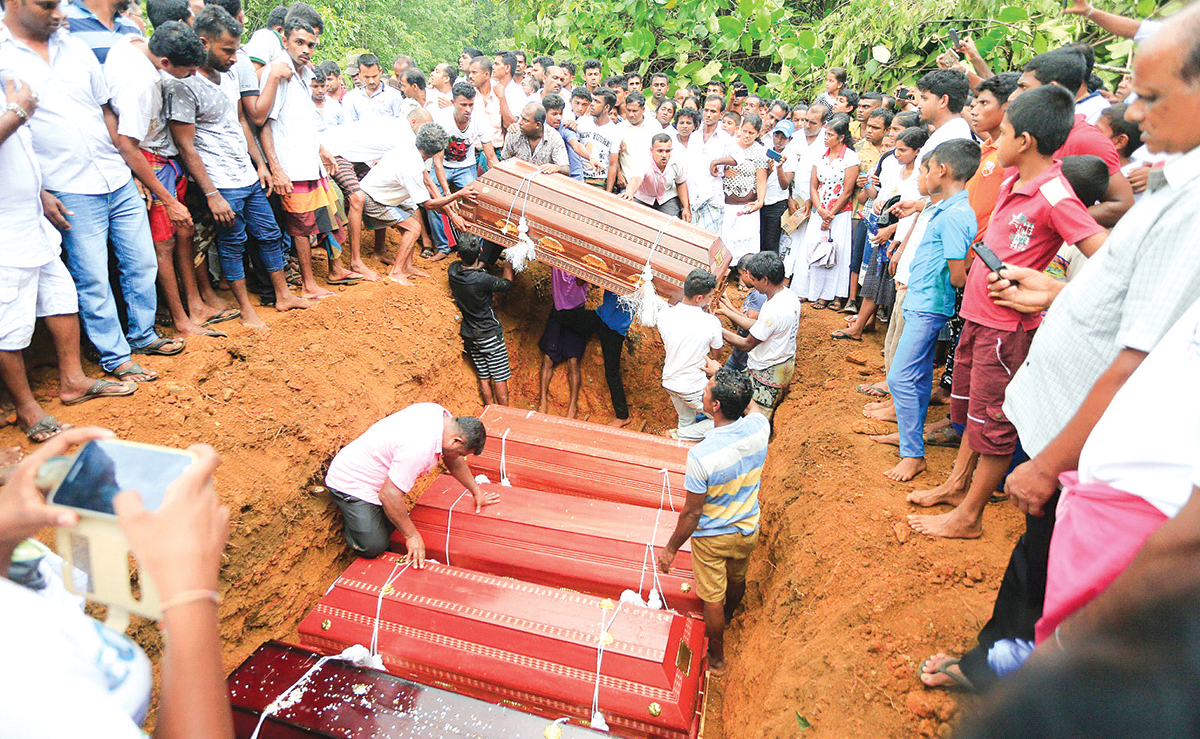
Eighteen Years of Delay:
Cyclone Ditwah has come and gone, leaving a trail of extensive damage to the country’s infrastructure, including buildings, roads, bridges, and 70% of the railway network. Thousands of hectares of farming land have been destroyed. Last but not least, nearly 1,000 people have lost their lives, and more than two million people have been displaced. The visuals uploaded to social media platforms graphically convey the widespread destruction Cyclone Ditwah has caused in our country.
The purpose of my article is to highlight, for the benefit of readers and the general public, how a project to establish a Doppler Weather Radar system, conceived in 2007, remains incomplete after 18 years. Despite multiple governments, shifting national priorities, and repeated natural disasters, the project remains incomplete.
Over the years, the National Audit Office, the Committee on Public Accounts (COPA), and several print and electronic media outlets have highlighted this failure. The last was an excellent five-minute broadcast by Maharaja Television Network on their News First broadcast in October 2024 under a series “What Happened to Sri Lanka”
The Agreement Between the Government of Sri Lanka and the World Meteorological Organisation in 2007.
The first formal attempt to establish a Doppler Radar system dates back to a Trust Fund agreement signed on 24 May 2007 between the Government of Sri Lanka (GoSL) and the World Meteorological Organisation (WMO). This agreement intended to modernize Sri Lanka’s meteorological infrastructure and bring the country on par with global early-warning standards.
The World Meteorological Organisation (WMO) is a specialized agency of the United Nations established on March 23, 1950. There are 193 member countries of the WMO, including Sri Lanka. Its primary role is to promote the establishment of a worldwide meteorological observation system and to serve as the authoritative voice on the state and behaviour of the Earth’s atmosphere, its interaction with the oceans, and the resulting climate and water resources.
According to the 2018 Performance Audit Report compiled by the National Audit Office, the GoSL entered into a trust fund agreement with the WMO to install a Doppler Radar System. The report states that USD 2,884,274 was deposited into the WMO bank account in Geneva, from which the Department of Metrology received USD 95,108 and an additional USD 113,046 in deposit interest. There is no mention as to who actually provided the funds. Based on available information, WMO does not fund projects of this magnitude.
The WMO was responsible for procuring the radar equipment, which it awarded on 18th June 2009 to an American company for USD 1,681,017. According to the audit report, a copy of the purchase contract was not available.
Monitoring the agreement’s implementation was assigned to the Ministry of Disaster Management, a signatory to the trust fund agreement. The audit report details the members of the steering committee appointed by designation to oversee the project. It consisted of personnel from the Ministry of Disaster Management, the Departments of Metrology, National Budget, External Resources and the Disaster Management Centre.
The Audit Report highlights failures in the core responsibilities that can be summarized as follows:
· Procurement irregularities—including flawed tender processes and inadequate technical evaluations.
· Poor site selection
—proposed radar sites did not meet elevation or clearance requirements.
· Civil works delays
—towers were incomplete or structurally unsuitable.
· Equipment left unused
—in some cases for years, exposing sensitive components to deterioration.
· Lack of inter-agency coordination
—between the Meteorology Department, Disaster Management Centre, and line ministries.
Some of the mistakes highlighted are incomprehensible. There is a mention that no soil test was carried out before the commencement of the construction of the tower. This led to construction halting after poor soil conditions were identified, requiring a shift of 10 to 15 meters from the original site. This resulted in further delays and cost overruns.
The equipment supplier had identified that construction work undertaken by a local contractor was not of acceptable quality for housing sensitive electronic equipment. No action had been taken to rectify these deficiencies. The audit report states, “It was observed that the delay in constructing the tower and the lack of proper quality were one of the main reasons for the failure of the project”.
In October 2012, when the supplier commenced installation, the work was soon abandoned after the vehicle carrying the heavy crane required to lift the radar equipment crashed down the mountain. The next attempt was made in October 2013, one year later. Although the equipment was installed, the system could not be operationalised because electronic connectivity was not provided (as stated in the audit report).
In 2015, following a UNOPS (United Nations Office for Project Services) inspection, it was determined that the equipment needed to be returned to the supplier because some sensitive electronic devices had been damaged due to long-term disuse, and a further 1.5 years had elapsed by 2017, when the equipment was finally returned to the supplier. In March 2018, the estimated repair cost was USD 1,095,935, which was deemed excessive, and the project was abandoned.
COPA proceedings
The Committee on Public Accounts (COPA) discussed the radar project on August 10, 2023, and several press reports state that the GOSL incurred a loss of Rs. 78 million due to the project’s failure. This, I believe, is the cost of constructing the Tower. It is mentioned that Rs. 402 million had been spent on the radar system, of which Rs. 323 million was drawn from the trust fund established with WMO. It was also highlighted that approximately Rs. 8 million worth of equipment had been stolen and that the Police and the Bribery and Corruption Commission were investigating the matter.
JICA support and project stagnation
Despite the project’s failure with WMO, the Japan International Cooperation Agency (JICA) entered into an agreement with GOSL on June 30, 2017 to install two Doppler Radar Systems in Puttalam and Pottuvil. JICA has pledged 2.5 billion Japanese yen (LKR 3.4 billion at the time) as a grant. It was envisaged that the project would be completed in 2021.
Once again, the perennial delays that afflict the GOSL and bureaucracy have resulted in the groundbreaking ceremony being held only in December 2024. The delay is attributed to the COVID-19 pandemic and Sri Lanka’s economic crisis.
The seven-year delay between the signing of the agreement and project commencement has led to significant cost increases, forcing JICA to limit the project to installing only one Doppler Radar system in Puttalam.
Impact of the missing radar during Ditwah
As I am not a meteorologist and do not wish to make a judgment on this, I have decided to include the statement issued by JICA after the groundbreaking ceremony on December 24, 2024.
“In partnership with the Department of Meteorology (DoM), JICA is spearheading the establishment of the Doppler Weather Radar Network in the Puttalam district, which can realize accurate weather observation and weather prediction based on the collected data by the radar. This initiative is a significant step in strengthening Sri Lanka’s improving its climate resilience including not only reducing risks of floods, landslides, and drought but also agriculture and fishery“.
Based on online research, a Doppler Weather Radar system is designed to observe weather systems in real time. While the technical details are complex, the system essentially provides localized, uptotheminute information on rainfall patterns, storm movements, and approaching severe weather. Countries worldwide rely on such systems to issue timely alerts for monsoons, tropical depressions, and cyclones. It is reported that India has invested in 30 Doppler radar systems, which have helped minimize the loss of life.
Without radar, Sri Lanka must rely primarily on satellite imagery and foreign meteorological centres, which cannot capture the finescale, rapidly changing weather patterns that often cause localized disasters here.
The general consensus is that, while no single system can prevent natural disasters, an operational Doppler Radar almost certainly would have strengthened Sri Lanka’s preparedness and reduced the extent of damage and loss.
Conclusion
Sri Lanka’s inability to commission a Doppler Radar system, despite nearly two decades of attempts, represents one of the most significant governance failures in the country’s disastermanagement history.
Audit findings, parliamentary oversight proceedings, and donor records all confirm the same troubling truth: Sri Lanka has spent public money, signed international agreements, received foreign assistance, and still has no operational radar. This raises a critical question: should those responsible for this prolonged failure be held legally accountable?
Now may not be the time to determine the extent to which the current government and bureaucrats failed the people. I believe an independent commission comprising foreign experts in disaster management from India and Japan should be appointed, maybe in six months, to identify failures in managing Cyclone Ditwah.
However, those who governed the country from 2007 to 2024 should be held accountable for their failures, and legal action should be pursued against the politicians and bureaucrats responsible for disaster management for their failure to implement the 2007 project with the WMO successfully.
Sri Lanka cannot afford another 18 years of delay. The time for action, transparency, and responsibility has arrived.
(The views and opinions expressed in this article are solely those of the author and do not necessarily reflect the policy or position of any organization or institution with which the author is affiliated).
By Sanjeewa Jayaweera
-

 Features5 days ago
Features5 days agoFinally, Mahinda Yapa sets the record straight
-
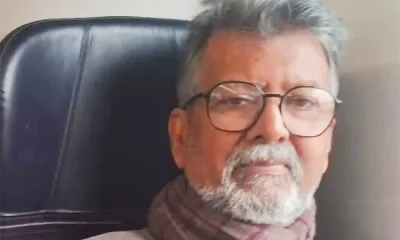
 News6 days ago
News6 days agoCyclone Ditwah leaves Sri Lanka’s biodiversity in ruins: Top scientist warns of unseen ecological disaster
-
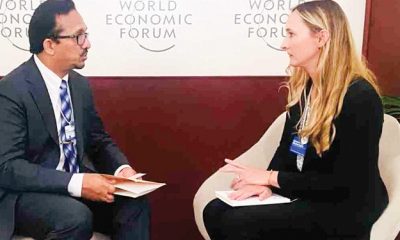
 Features5 days ago
Features5 days agoHandunnetti and Colonial Shackles of English in Sri Lanka
-
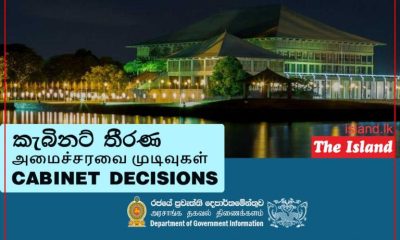
 Business4 days ago
Business4 days agoCabinet approves establishment of two 50 MW wind power stations in Mullikulum, Mannar region
-
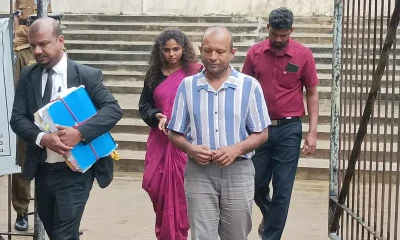
 News4 days ago
News4 days agoGota ordered to give court evidence of life threats
-
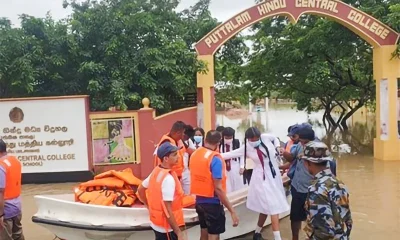
 Features6 days ago
Features6 days agoAn awakening: Revisiting education policy after Cyclone Ditwah
-

 Features4 days ago
Features4 days agoCliff and Hank recreate golden era of ‘The Young Ones’
-

 Opinion5 days ago
Opinion5 days agoA national post-cyclone reflection period?


